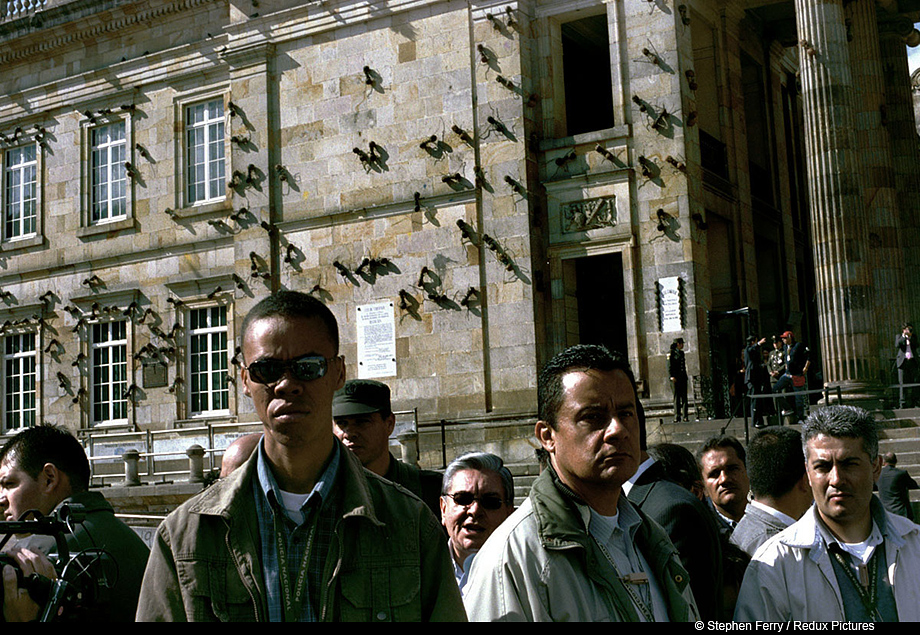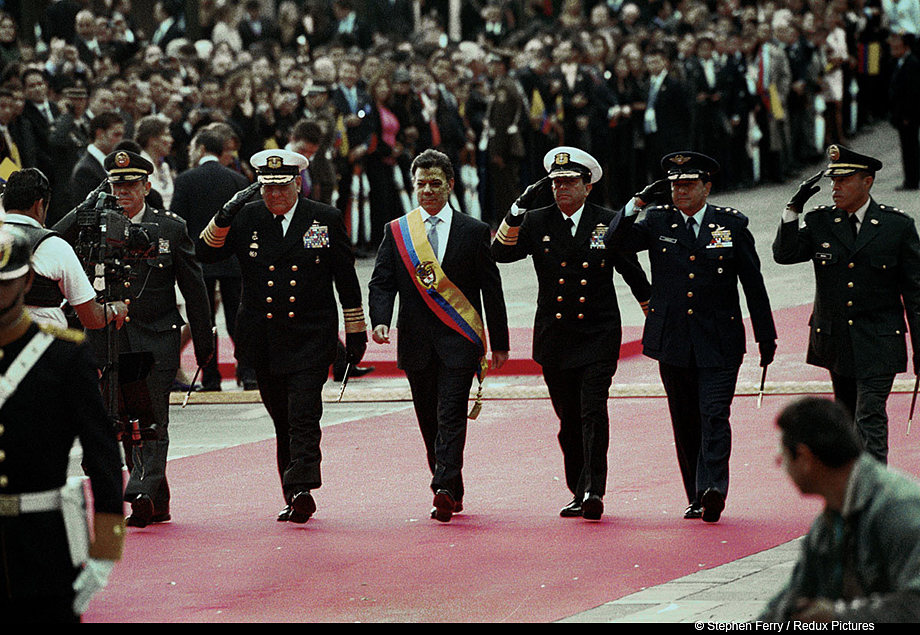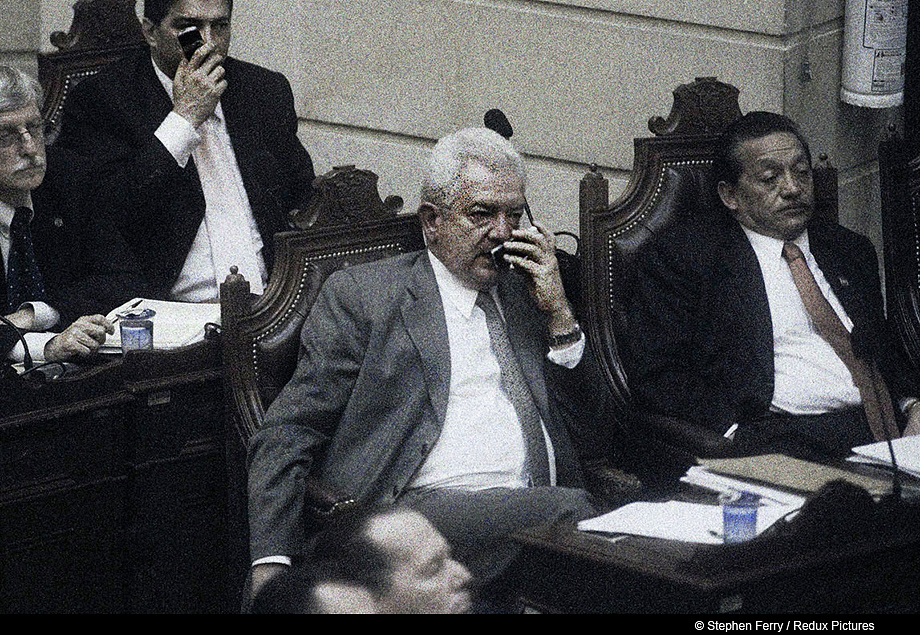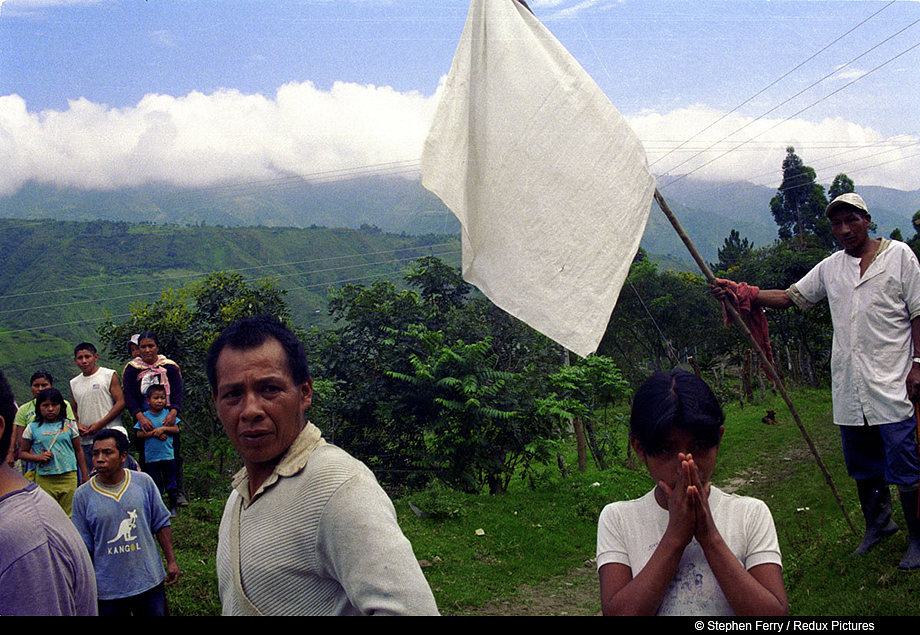Notes
Stephen Ferry's "Colombia Ongoing": Ants Storm Congress
As part of an occasional series, Colombia Ongoing, Stephen Ferry issues this update on the key players in the post-election environment, his photographs telling the story with extended captions.
Colombian artist Rafael Gomez Barros put hundreds of ants on the front of the National Congress in February. The fiberglass insects, whose heads and tails were shaped as human skulls, represent the millions of Colombians displaced by violence. While the artist insists that his work is strictly apolitical, observers connected it to the fact that dozens of congressmen are under investigation for conspiring with the paramilitary militias that – along with leftist guerrillas – have displaced over three million peasants from the land. In the center of the photo above, surrounded by bodyguards, we see Fabio Valencia Cossio, now ex-Justice Minister, whose brother is in jail for collaborating with “Don Mario,” a major cocaine trafficker and paramilitary commander, while serving as Attorney General for the city of Medellín.
Newly inaugurated President Juan Manuel Santos insists that his administration will be free of the corruption scandals that infested the government of Alvaro Uribe.
Santos was inaugurated on August 7, in a heavily guarded act held in Bogotá’s Plaza de Bolivar. The ceremony featured the new president parading around the square, flanked by the commanders of the country’s armed forces, his relaxed yet martial stride testifying to his aristocratic origins and the confidence with which he wields power. Great-nephew of a former president, Santos is member of one of the handful of old families that still run Colombia. He was Defense Minister under President Alvaro Uribe, while his cousin, Francisco Santos, was Uribe’s vice-president.
Although Santos ran on the promise of continuing Uribe’s hardline against leftist guerrillas, he has shrewdly tried to distance himself from Uribe’s combative attitudes, particularly in relation to Colombia’s Supreme Court. The court is prosecuting many allies of Uribe and Santos, including cousin Senator Mario Uribe (in above photo), for conspiring with murderous right-wing death squads. President Uribe tirelessly denounced the court as allied with the guerrillas. A campaign of wiretapping, harassment and threats against the court, journalists, human rights defenders and opposition politicians was traced back to Uribe’s office; by contrast, one of Santos’s first acts as President was to meet with judges.
Behind Santos’s eagerness to distance himself from Uribe on human rights and the rule of law lies the fear that the International Criminal Court may take up the Colombian case. International investigators, not vulnerable to intimidation, could prosecute ex-President Uribe and expose a vast system of collusion between the armed forces and illegal paramilitaries.
Colombians wonder what will happen if the justice system operates freely. Will investigations find Uribe responsible for the wiretap scandal, or guilty of collaborating with paramilitaries going back to his years as the Governor of Antioquia? Might Santos himself be linked to major human rights abuses when he was Defense Minister? In the grotesque “False Positives” case, the military systematically assassinated over a thousand innocent civilians, dressed them up as guerrillas, and claimed them as battlefield victories. As Defense Minister, Santos responded by cashiering a number of generals and colonels for the crimes, but also lashed out against critics, claiming the scandal was a plot to discredit the Armed Forces.
Meanwhile, sadly enough, Colombia’s internal armed conflict shows little sign of ending. Despite gains against the Revolutionary Armed Forces of Colombia (FARC), fueled by Uribe’s hatred for the guerrillas who killed his father, and over a billion dollars in US military aid, the FARC survives to welcome in the new president with a rash of deadly attacks. The army responded by reportedly killing 27 rebels, including a regional commander. Paramilitary groups — with names like the Black Eagles, The Weeds, and the Revolutionary Popular Anti-Subversive Army — continue to operate in many areas, threatening trade unionists, peasant leaders and human rights activists in the name of counter-insurgency.
–Stephen Ferry
PHOTOGRAPHS by STEPHEN FERRY / Redux Pictures
captions: (top) Ants on the Congress, Bogota.
(2nd photo) JUAN MANUEL SANTOS TAKES OFFICE AS PRESIDENT OF COLOMBIA IN A CEREMONY HELD IN BOGOTA’S PLAZA DE BOLIVAR. AUG. 7, 2010
(3rd photo) Senator Mario Uribe, now under investigation for conspiring with paramilotary militias to gain office, seen in the chambers of the Congress.
(bottom) Civilians seek to protect themselves during combat between the Colombian army and Revolutionary Armed Forces of Colombia (FARC) guerrillas, outside the town of Jamundí, Norte de Valle, about 20 miles to the south of Cali. July, 2010






Reactions
Comments Powered by Disqus